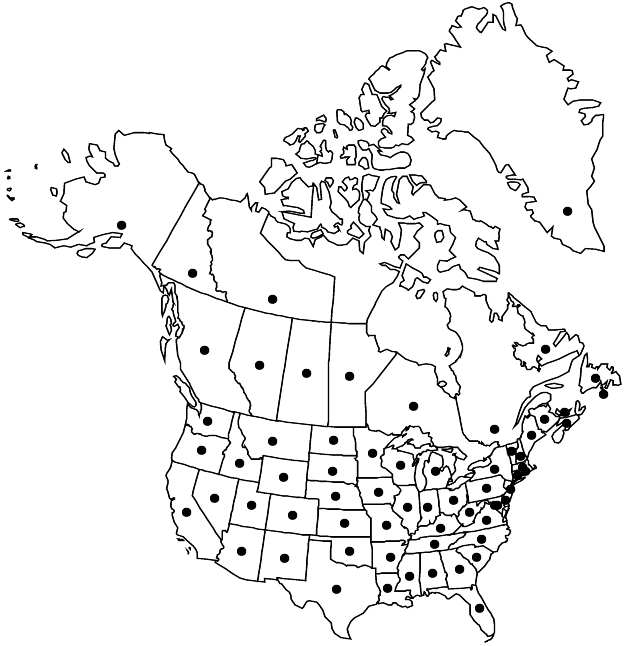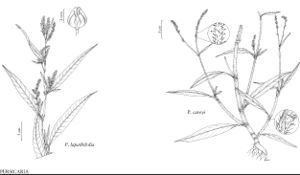Persicaria lapathifolia
Nat. Arr. Brit. Pl. 2: 270. 1822.
Plants annual, (0.5–)1–10 dm; roots also sometimes arising from proximal nodes; rhizomes and stolons absent. Stems ascending to erect, simple or branched, scarcely ribbed, glabrous or, rarely, appressed-pubescent distally, sometimes glandular-punctate or stipitate-glandular distally. Leaves: ocrea brownish, cylindric, 4–24(–35) mm, chartaceous, base inflated, margins truncate, eciliate or ciliate with bristles to 1 mm, surface glabrous, rarely strigose, eglandular; petiole 0.1–1.6 cm, usually strigose, sometimes glabrous; blade sometimes with dark triangular or lunate blotch adaxially, narrowly to broadly lanceolate, 4–12(–22) × (0.3–)0.5–4(–6) cm, base tapering to cuneate, margins antrorsely scabrous, apex acuminate, faces strigose on main veins, glabrous or tomentose abaxially, glandular-punctate abaxially. Inflorescences mostly terminal, sometimes also axillary, mostly arching or nodding, usually uninterrupted, 30–80 × 5–12 mm; peduncle 2–25 mm, often stipitate-glandular; ocreolae usually overlapping, margins eciliate or ciliate with bristles to 0.4 mm. Pedicels ascending, 0.5–2.3 mm. Flowers 4–14 per ocreate fascicle, homostylous; perianth greenish white to pink, glabrous, not glandular-punctate or glandular-punctate with punctae mostly on tubes and inner tepals, scarcely accrescent; tepals 4(–5), connate ca. 1/4–1/3 their length, obovate to elliptic, 2.5–3 mm, veins prominent, those of 2 or 3 outer tepals prominently bifurcate distally, anchor-shaped, margins entire, apex obtuse to rounded; stamens 5–6, included; anthers pink or red, elliptic; styles 2(–3), connate at bases. Achenes included or apex exserted, brown to black, discoid or, rarely, 3-gonous, 1.5–3.2 × 1.6–3 mm, shiny or dull, smooth. 2n = 22.
Phenology: Flowering (Apr-)Jul–Nov.
Habitat: Moist places, roadsides, floodplains, waste places, cultivated fields
Elevation: 0-1500(-1800) m
Distribution

Greenland, St. Pierre and Miquelon, Alta., B.C., Man., N.B., Nfld. and Labr., N.W.T., N.S., Ont., P.E.I., Que., Sask., Yukon, Ala., Alaska, Ariz., Ark., Calif., Colo., Conn., Del., D.C., Fla., Ga., Idaho, Ill., Ind., Iowa, Kans., Ky., La., Maine, Md., Mass., Mich., Minn., Miss., Mo., Mont., Nebr., Nev., N.H., N.J., N.Mex., N.Y., N.C., N.Dak., Ohio, Okla., Oreg., Pa., R.I., S.C., S.Dak., Tenn., Tex., Utah, Vt., Va., Wash., W.Va., Wis., Wyo., Mexico, South America, Europe, Asia, Africa, Pacific Islands (New Zealand).
Discussion
Persicaria lapathifolia is a morphologically variable complex with more than two-dozen infraspecific taxa described in the New World and Old World. An allozyme study by L. L. Consaul et al. (1991) did not support recognition of elements often referred to Polygonum lapathifolium var. salicifolium or P. scabrum, which are synonymized here. Yang J. and Wang J. W. (1991) reached a similar conclusion regarding var. salicifolium and P. nodosum based on their morphometric analysis.
The Keres, Navajo, and Potawatomi prepared medicinal infusions with Persicaria lapathifolia, and the Zuni used decoctions made from the plants as cathartic and emetic drugs (D. E. Moerman 1998).
Selected References
None.
